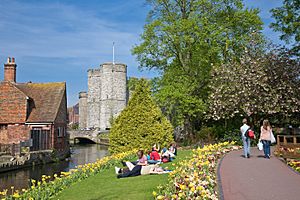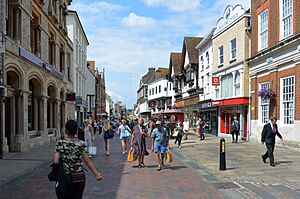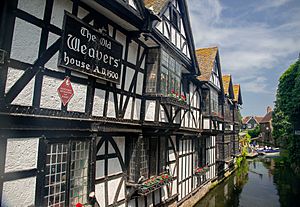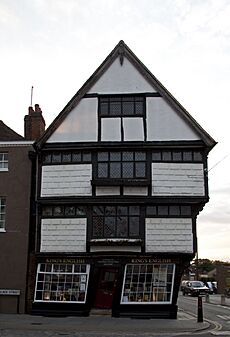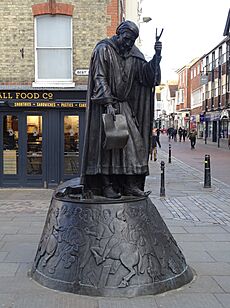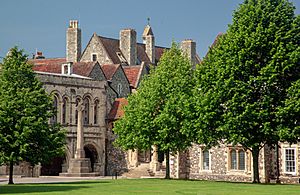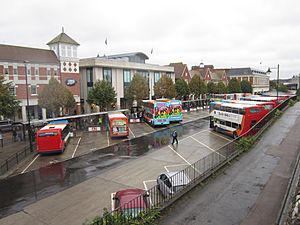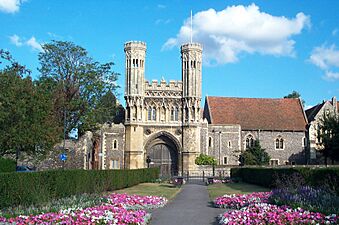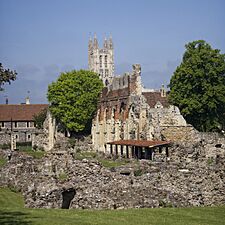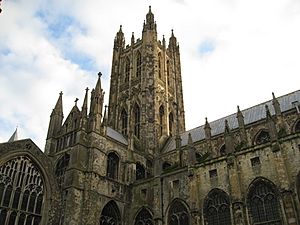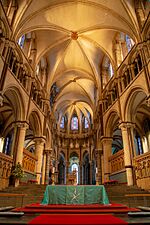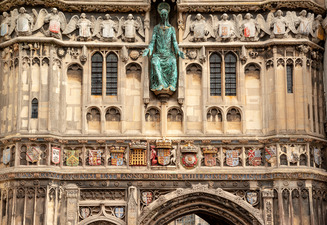Canterbury facts for kids
Quick facts for kids Canterbury |
|
|---|---|
| City | |
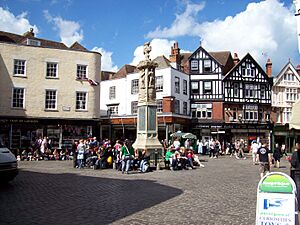 Butter Market square |
|
 Arms of Canterbury |
|
| Population | 55,240 (2011) |
| OS grid reference | TR145575 |
| • London | 54 miles (87 km) |
| District |
|
| Shire county | |
| Region | |
| Country | England |
| Sovereign state | United Kingdom |
| Post town | CANTERBURY |
| Postcode district | CT1, CT2, CT4 |
| Dialling code | 01227 |
| Police | Kent |
| Fire | Kent |
| Ambulance | South East Coast |
| EU Parliament | South East England |
| UK Parliament |
|
Canterbury is a famous city and a UNESCO World Heritage Site in Kent, England. It sits on the River Stour. The city has a mild, pleasant climate.
Canterbury is a very popular place for tourists. Its economy relies a lot on visitors, universities, and shops. In 2011, over 55,000 people lived here, including many students. Canterbury has one of the highest numbers of students compared to permanent residents in Britain!
People have lived in the Canterbury area since the Stone Age. It was once the capital for the Celtic Cantiaci tribe and later the Jute Kingdom of Kent. Many old buildings are still here. These include a city wall built by the Romans and rebuilt in the 1300s. You can also see the Westgate Towers museum, the ruins of St Augustine's Abbey, and the Norman Canterbury Castle. The King's School here is the oldest school still running in the world! Newer places include the Marlowe Theatre and Kent County Cricket Club's St Lawrence Ground. Canterbury Cathedral is famous for its amazing architecture and music. It is also the home of the Archbishop of Canterbury and gets a million visitors every year.
Contents
History of Canterbury
What is the origin of Canterbury's name?
When the Romans settled here, they called the town Durovernum Cantiacorum. This meant "Kentish Durovernum". The name might have come from an older British word for "stronghold by the alder grove". It could also be linked to the Stour.
Later, in Sub-Roman Britain, it was known as Cair Ceint in Old Welsh. This meant "stronghold of Kent". When the Jutes arrived, they called it Cantwareburh. This meant "stronghold of the Kentish men". This is where the name Canterbury comes from today.
How did Canterbury begin?
The Canterbury area has been lived in since ancient times. Tools from the Stone Age and pots from the Bronze Age have been found here. Canterbury was first known as the main town of the Celtic tribe called the Cantiaci. This tribe lived in most of what is now Kent.
In the 1st century AD, the Romans took over the settlement. They named it Durovernum Cantiacorum. The Romans rebuilt the city with new streets in a grid pattern. They also added a theatre, a temple, a forum, and public baths. Even though they did not have a large army base, its location on Watling Street was very important. It was close to major ports like Rutupiae (Richborough), Dubrae (Dover), and Lemanae (Lymne).
In the late 3rd century, the Romans built an earth bank and a wall around the city. This was to protect against attacks from barbarians. The wall had seven gates and covered about 130 acres.
After the Romans left Britain in 410, Durovernum Cantiacorum was mostly empty for about 100 years. Only a few farmers lived there, and the city slowly fell apart. Over the next century, an Anglo-Saxon community grew inside the city walls. Jutish people arrived, possibly mixing with the locals. The town became important again, and trades like pottery, textiles, and leather grew. By 630, gold coins were being made at the Canterbury mint. In 842 and 851, Canterbury suffered greatly from Danish raids.
What happened in Canterbury during the Middle Ages?
In 1011, a large Viking army attacked Canterbury. They took over and looted the city. Because of this destruction, the people of Canterbury did not fight William the Conqueror when he invaded in 1066. William quickly ordered a wooden motte-and-bailey castle to be built near the Roman city wall. In the early 1100s, the castle was rebuilt with stone.
The Black Death arrived in Canterbury in 1348. At that time, Canterbury had about 10,000 people, making it the 10th largest city in England. But by the early 1500s, the population had dropped to just 3,000.
During the Hundred Years' War, in 1363, a group found that the Roman wall was falling apart. People had been taking stones from it and filling in its ditches. Between 1378 and 1402, the wall was almost completely rebuilt. New towers were added to it.
In 1381, during Wat Tyler's Peasants' Revolt, the castle and the Archbishop's Palace were attacked. Archbishop Sudbury was killed in London. In 1413, King Henry IV was buried at the cathedral. He is the only king to be buried there. In 1448, Canterbury was given a City Charter. This meant it could have a mayor and a high sheriff. The city still has a Lord Mayor and Sheriff today.
Who were the Huguenots in Canterbury?
In the mid-1500s, many Huguenots (French Protestants) faced hardship and conflict in Europe. They fled and found new homes in places like England. Canterbury welcomed the first group of these 'refugee strangers' in the country. The first Huguenot church in Canterbury started around 1548.
When Mary I became queen, the Huguenots in Canterbury had to leave in 1553–54. They went to other cities in Europe. After Elizabeth I became queen, some Huguenots returned to England. In 1561, many Huguenots from London were sent to Sandwich. This town grew quickly with new refugees. In 1575, almost all of them moved to Canterbury.
In 1575, the Huguenots in Canterbury were allowed to use the church of St Alphege. The next year, they began using the crypt (an underground room) of Canterbury Cathedral as their church. This crypt church quickly became the heart of the Huguenot community in Canterbury.
By the 1600s, French-speaking Huguenots made up two-fifths of Canterbury's population. They had a big impact on the city's economy. They brought silk weaving to the city, which became more important than wool weaving by 1676.
How did Canterbury change from the 1600s to today?
Canterbury remained an important city in the 1600s. King Charles I and his wife Henrietta Maria visited in 1625. In 1647, during the English Civil War, riots broke out. These were called the "Plum Pudding Riots". The trial of the rioters led to a revolt in Kent against Parliament, helping to start the second part of the war. However, Canterbury peacefully gave up to Parliament's forces.
By 1770, the castle was falling apart. Many parts were pulled down in the late 1700s and early 1800s. In 1787, all the gates in the city wall were removed, except for Westgate. This was because they made it hard for new coaches to travel. Canterbury Prison opened in 1808 just outside the city.
By 1820, silk weaving had been replaced by imported Indian fabrics. Trade then focused on hops and wheat. The Canterbury & Whitstable Railway, also known as "The Crab and Winkle Way", opened in 1830. It was the world's first passenger railway. It closed in 1953. Between 1830 and 1900, the city's population grew from 15,000 to 24,000.
During the First World War, army barracks and hospitals were set up in the city. Mahatma Gandhi visited Canterbury in October 1931.
During the Second World War, Canterbury was bombed 135 times. Over 10,000 bombs were dropped, destroying many homes and buildings. 119 people in the city died. The worst raid was on June 1, 1942, during the Baedeker Blitz. After the war, plans were made to rebuild the city center. However, locals did not like the plans, and a group called the Citizens' Defence Association was formed. They won the local elections in 1945.
Rebuilding of the city center finally started 10 years after the war. A ring road was built outside the city walls to help with traffic. The city center later became a pedestrian area. The biggest growth for the city happened in the 1960s. This was when the University of Kent at Canterbury and Christ Church College were built.
The 1980s saw visits from Queen Elizabeth II and the start of the yearly Canterbury Festival. Between 1999 and 2005, the Whitefriars Shopping Centre was greatly redeveloped. In 2000, during this work, a big archaeological dig took place. It was supported by Channel Four's Time Team.
Geography and Climate
What is Canterbury's climate like?
Canterbury has an oceanic climate, which is common in the United Kingdom. This means it has mild temperatures all year round. Temperatures usually stay between 1.8 °C (35.2 °F) and 22.8 °C (73 °F). There is also not much rainfall throughout the year.
| Climate data for Canterbury | |||||||||||||
|---|---|---|---|---|---|---|---|---|---|---|---|---|---|
| Month | Jan | Feb | Mar | Apr | May | Jun | Jul | Aug | Sep | Oct | Nov | Dec | Year |
| Mean daily maximum °C (°F) | 7.6 (45.7) |
7.8 (46.0) |
10.7 (51.3) |
13.4 (56.1) |
16.8 (62.2) |
20.0 (68.0) |
22.8 (73.0) |
22.8 (73.0) |
19.4 (66.9) |
15.3 (59.5) |
10.9 (51.6) |
8.1 (46.6) |
14.7 (58.5) |
| Daily mean °C (°F) | 4.3 (39.7) |
4.3 (39.7) |
6.4 (43.5) |
8.2 (46.8) |
11.6 (52.9) |
14.3 (57.7) |
16.8 (62.2) |
16.9 (62.4) |
14.3 (57.7) |
10.9 (51.6) |
7.1 (44.8) |
5.3 (41.5) |
10.0 (50.0) |
| Mean daily minimum °C (°F) | 2.1 (35.8) |
1.8 (35.2) |
3.5 (38.3) |
4.9 (40.8) |
7.7 (45.9) |
10.5 (50.9) |
12.9 (55.2) |
12.8 (55.0) |
10.8 (51.4) |
8.0 (46.4) |
4.8 (40.6) |
2.5 (36.5) |
6.9 (44.4) |
| Average precipitation mm (inches) | 62.2 (2.45) |
42.2 (1.66) |
41.3 (1.63) |
42.9 (1.69) |
50.0 (1.97) |
39.0 (1.54) |
40.0 (1.57) |
51.2 (2.02) |
61.6 (2.43) |
83.2 (3.28) |
68.8 (2.71) |
63.4 (2.50) |
645.8 (25.43) |
| Mean monthly sunshine hours | 60.9 | 80.7 | 116.5 | 174.2 | 206.0 | 206.4 | 221.8 | 214.9 | 155.2 | 125.0 | 73.3 | 48.6 | 1,683.3 |
What is Canterbury's population like?
In 2001, the city of Canterbury had 43,432 people. The wider Canterbury district had 135,278 people. By 2011, the city's population grew to over 55,000. The district population reached 151,200, an 11.7% increase from 2001.
By 2015, Canterbury had almost 40,000 students. This includes students from the University of Kent, Canterbury Christ Church University, and the smaller University for the Creative Arts.
| Year | 1901 | 1911 | 1921 | 1931 | 1939 | 1951 | 1961 | 1971 | 2001 | |||||||||
|---|---|---|---|---|---|---|---|---|---|---|---|---|---|---|---|---|---|---|
| Population | 24,899 | 24,626 | 23,737 | 24,446 | 26,999 | 27,795 | 30,415 | 33,155 | 43,432 | |||||||||
| Source: A Vision of Britain through Time | ||||||||||||||||||
Where is Canterbury located?
Canterbury is in eastern Kent, about 55 miles (89 km) southeast of London. The coastal towns of Herne Bay and Whitstable are 6 miles (10 km) to the north. Faversham is 8 miles (13 km) to the northwest.
The city is on the River Stour or Great Stour. You can sail boats on the tidal part of the river up to Fordwich. Above that point, smaller boats like canoes can be used. The ground in the area is mostly brickearth over chalk.
Canterbury is a medieval city. Canterbury Cathedral is inside the city walls, forming the historic center. Part of the medieval walls remains to the south, near Canterbury Castle. To the northwest, the Westgate still stands as the Westgate Towers museum. Just outside the Westgate is the River Stour, which flows through the city. A main road runs straight through the city from the Westgate, forming the High Street. St Augustine's Abbey is just outside the city walls.
What is Canterbury's economy like?
In 2001, the Canterbury district had about 4,761 businesses. These businesses employed up to 60,000 people, both full-time and part-time. The district's economy was worth £1.3 billion, making it the second largest in Kent. Today, the three main parts of the economy are tourism, higher education, and retail.
In 2015, tourism brought over £450 million to Canterbury. That year, 7.2 million people visited, making it one of the most visited cities in England. Tourism supported 9,378 jobs, which was a 6% increase from the year before. The two universities brought even more benefits. In 2014/2015, the University of Kent and Canterbury Christ Church University added £909 million to the city's economy. They also accounted for 16% of all jobs.
Unemployment in the city dropped from 3.0% in 2001 to 1.7% in 2007. By May 2018, the rate was 1.8%. This data only counts people receiving unemployment benefits. At that time, the national rate was 4.2%.
Culture in Canterbury
What are the main landmarks in Canterbury?
The Crooked House is a 17th-century bookshop. It is known for its slanted look and is often photographed. The Canterbury Roman Museum has a real mosaic floor from around 300 AD. Other Roman buildings include Queningate, a blocked gate in the city wall, and the Dane John Mound. This mound was once part of a Roman cemetery. The Dane John Gardens were built next to the mound in the 1700s.
The Westgate Towers is a museum that tells the story of its past use as a jail. The medieval church of St Alphege is now used by the King's School. The Old Synagogue, now the King's School Music Room, is one of only two Egyptian Revival synagogues still standing. The city center has many timber-framed houses from the 1500s and 1600s. Some were destroyed in the Second World War. Survivors include the Huguenot "Old Weaver's House". St Martin's Mill is the only surviving mill in Canterbury. It was built in 1817 and is now a home.
What theatres are in Canterbury?
The Marlowe Theatre is named after Christopher Marlowe, who was born in Canterbury. It moved to its current location in 1984. It was completely rebuilt in 2011. It has a main auditorium with 1,200 seats and a smaller performance space. Its modern building is a well-known landmark in the city.
The University of Kent's Gulbenkian Theatre also serves the city. It includes a cinema and a café. Other plays and performances happen at Canterbury Cathedral and St Augustine's Abbey. The oldest theatre building still standing in Canterbury is The Shakespeare bar. It used to be a playhouse in the Tudor period. Theatre companies in Canterbury include The Canterbury Players.
What kind of music is popular in Canterbury?
Like many English towns in the Middle Ages, Canterbury had a group of musicians called waits. Records show payments to the waits from 1402. They were stopped in 1641 but brought back in 1660. They played for King Charles II when he returned from exile. A modern group called The Canterbury Waits has brought the name back.
Canterbury's Catch Club was a music club that met from 1779 to 1865. Its male members met weekly in winter. They had an orchestra for the first part of their evening. After a break, members sang catches and glees. Their music library is now kept at Canterbury Cathedral.
In the late 1960s and early 1970s, the Canterbury Scene started. This was a group of progressive rock, avant-garde, and jazz musicians from the city. Bands included Soft Machine, Caravan, and Hatfield and the North. Ian Dury, a rock star from the 1970s, taught art at Canterbury College of Art. His early band, Kilburn and The High Roads, played in the city.
The Canterbury Choral Society performs classical choral music regularly at Canterbury Cathedral. The Canterbury Orchestra, started in 1953, plays major symphonic works. Other local music groups include the Canterbury Singers and the City of Canterbury Chamber Choir.
The Canterbury Festival happens for two weeks in October. It includes music events from opera and symphony concerts to world music, jazz, and folk.
What sports are played in Canterbury?
Cricket Canterbury is home to Kent County Cricket Club. The St Lawrence Ground hosts many of the team's matches. It has also been used for international cricket games. The St Lawrence Ground is special because it is one of only two cricket grounds with a tree inside the playing area.
American Football Canterbury has had several American football teams. Currently, the city is home to the East Kent Mavericks. Both universities also have teams.
Football Canterbury City F.C. restarted in 2007. They play in the Southern Counties East Football League. The club had stopped playing in 2001.
Rugby Canterbury RFC was founded in 1926. They were the first East Kent club to reach a national league. They currently play in the fourth tier, National League 2 South.
Tour de France The cycling Tour de France race passed through the city in 1994. It came through again in 2007, when it hosted the finish for Stage 1.
Hockey Canterbury Hockey Club is one of the biggest in the country. It has teams in both the men's and women's national leagues. Former Olympic gold medalist Sean Kerly was a member.
Public Facilities Public sports facilities are available at Kingsmead Leisure Centre. These include a 33-meter (108 ft) swimming pool and a sports hall for football, basketball, and badminton.
Education in Canterbury
What universities are in Canterbury?
Canterbury has about 31,000 students. It has the highest number of students compared to permanent residents in the UK. They attend three universities and other higher education places. The University of Kent's main campus is on Saint Stephen's Hill. It is about a mile north of Canterbury city center and covers 600 acres (240 ha). In 2014, it had about 20,000 students.
Canterbury Christ Church University started as a teacher training college in 1962. It was founded by the Church of England. In 2005, it became a university. In 2007, it had about 15,000 students. The Franciscan International Study Centre is near the University of Kent campus.
What schools are in Canterbury?
King's School is the oldest secondary school in the United Kingdom. St. Augustine started it soon after he arrived in Canterbury in 597. However, written history of it only began after the dissolution of the monasteries in the 1500s. That is when it got its current name, honoring Henry VIII.
The city's secondary grammar schools are Barton Court Grammar School, Simon Langton Grammar School for Boys, and Simon Langton Girls' Grammar School. In 2008, over 93% of their students achieved good grades in their GCSEs, including English and maths.
Transport in Canterbury
How do people travel by train in Canterbury?
The first passenger railway in the world, the Canterbury & Whitstable Railway, was known as the Crab and Winkle line. It had a station at North Lane. It ran from May 3, 1830, to 1953. Canterbury South railway station was on the Elham Valley Railway. It opened in 1889 and closed in 1947.
Canterbury West railway station is run by Southeastern. Canterbury East railway station, the city's other station, is also run by Southeastern. There is no direct connection between Canterbury West and Canterbury East stations. This is because the two railways were built by different companies. A new station, Canterbury Parkway railway station, has been suggested outside the city. It would connect to both lines.
How do people travel by bus in Canterbury?
Stagecoach operates local bus routes in Canterbury, as well as longer-distance services. Their 'Unibus' service uses bio fuel and runs between the city center and the University of Kent. Canterbury has two park and ride sites, at Wincheap and New Dover Road. These are for visitors arriving from the south by road.
Can you cycle in Canterbury?
National Cycle Route 1 goes through Canterbury. It runs from Dover and Sandwich to Whitstable. National Cycle Route 18 runs from Canterbury to Ashford.
Local Media
What newspapers are in Canterbury?
Canterbury's first newspaper was the Kentish Post, started in 1717. It joined with the new Kentish Gazette in 1768. This newspaper is still published today and claims to be the second oldest surviving newspaper in the country. It is produced by KM Group in Whitstable.
Three free weekly newspapers provide local news. The Daily Mail and General Trust's Canterbury Times has a circulation of 55,000. The Canterbury Extra is owned by KM Group. yourcanterbury is published by KOS Media.
What radio stations are in Canterbury?
Local radio stations include BBC Radio Kent on 104.2FM, Heart South on 102.8FM, and KMFM Canterbury on 106FM. KMFM Canterbury used to be KMFM106. Its studio moved from the city to Ashford in 2008. Canterbury Hospital Radio serves Kent and Canterbury Hospital.
From 2007 to 2020, Canterbury also had CSR 97.4FM. This was the country's first student-led community radio station. CSR stood for "Canterbury Student Radio". It served students from the University of Kent and Canterbury Christ Church University, as well as the wider community. In 2020, the station stopped broadcasting on FM due to rising costs. It has been broadcasting online since then.
What TV channels are available in Canterbury?
Local news and TV shows are provided by BBC South East and ITV Meridian. These come from the Dover TV transmitter.
Famous People from Canterbury
Composer Orlando Gibbons (1583–1625) died in Canterbury. He has a memorial in the cathedral. The grave of author Joseph Conrad in Canterbury Cemetery is a special listed building.
Other famous people connected to Canterbury include:
- Aphra Behn, a playwright and novelist
- Orlando Bloom, an actor
- Thomas Sidney Cooper, a painter
- David Gower, a cricketer
- William Harvey, a physician
- Christopher Marlowe, a poet and playwright
- W. Somerset Maugham, a writer
- Pink Pantheress, a singer
- Joseph McManners, a singer and actor
- Fiona Phillips, a TV presenter
- Trevor Pinnock, a musician
- Michael Powell, a film director
- Mary Tourtel, who created Rupert Bear
- Mimi Webb, a singer
International Connections
Canterbury is twinned with these cities:
- Reims, France
- Esztergom, Hungary
- Saint-Omer, France (since 1995)
- Wimereux, France (since 1995)
- Certaldo, Italy (since 1997)
- Vladimir, Russia (since 1997)
- Mölndal, Sweden (since 1997)
- Tournai, Belgium (since 1999)
- Bloomington, Illinois, United States
Religion in Canterbury
In 597, Pope Gregory the Great sent Augustine to convert King Æthelberht to Christianity. After the king became Christian, Augustine chose Canterbury as the center for his church in Kent. An abbey and a cathedral were built. Augustine became the first Archbishop of Canterbury. In 672, the Synod of Hertford gave the Archbishop of Canterbury power over the entire English Church.
In 978, Archbishop Dunstan rebuilt the abbey that Augustine had built. He named it St Augustine's Abbey. In 1504, the cathedral's main tower, the Bell Harry Tower, was finished. This ended 400 years of building.
After Archbishop Thomas Becket was killed at the cathedral in 1170, Canterbury became one of the most famous towns in Europe. People from all over Christian lands came to visit his shrine. This pilgrimage inspired Geoffrey Chaucer's 14th-century stories, The Canterbury Tales.
In 1538, King Henry VIII ordered Thomas Becket's shrine in the cathedral to be destroyed. All the gold, silver, and jewels were taken to the Tower of London. Becket's images, name, and special days were removed throughout the kingdom. This ended the pilgrimages.
In 1620, Robert Cushman arranged to lease the Mayflower at 59 Palace Street. This ship carried the Pilgrims to America. In 1647, during the English Civil War, riots broke out. This happened when Canterbury's mayor banned church services on Christmas Day.
In 1848, St Augustine's Abbey was restored. It was used as a missionary college for the Church of England's representatives in the British colonies. The cathedral underwent major restoration work from 2016 to 2021. This included replacing the nave roof and improving visitor facilities. This project was expected to cost nearly £25 million.
Canterbury Cathedral is the main church of the Anglican Communion and the home of the Archbishop of Canterbury. It was founded in 597 AD by Augustine. It is a World Heritage Site, along with Saxon St. Martin's Church and the ruins of St Augustine's Abbey. The cathedral gets a million visitors every year. Services are held three or more times a day.
St Thomas of Canterbury Church is the only Roman Catholic church in the city. It holds relics of Thomas Becket.
See also
In Spanish: Canterbury para niños





